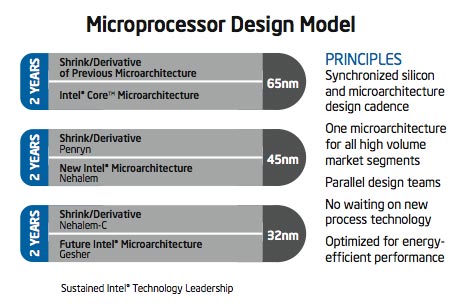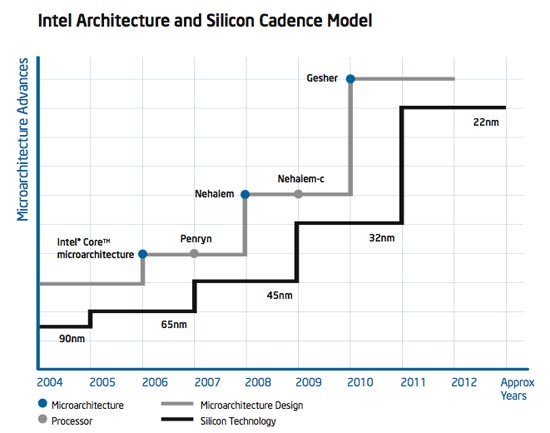Intel's Core 2 Extreme QX6700: The Multi-core Era Begins
by Anand Lal Shimpi on November 2, 2006 2:14 AM EST- Posted in
- CPUs
Analyzing Efficiency Trends
The graph below summarizes the data pretty well; what you're looking at is a graph of normalized performance per watt in six applications as a function of the number of cores in a Core micro-architecture CPU:

The graph illustrates exactly what we've confirmed here today: having more cores does increase efficiency if the software is designed to take advantage of those additional cores.
We have not yet hit the point of diminishing returns with adding more cores, but the two downward trending curves show the current problem with scaling from two to four cores. Very few desktop applications can take good advantage of a dual core CPU and even fewer are geared for quad core chips, and in those applications these quad core processors are actually a step back in terms of efficiency; it's not a fault of the processor, but rather of the software.
Through the benchmarks on the previous page we also highlighted another important point to take away: even in the areas where performance and efficiency were both improved, they came at a very expensive cost: twice the transistor count of Core 2 Duo. As much as Intel may call the next decade the era of multi-core and thread level parallelism, we simply can't lose focus on improving instruction level parallelism and core level efficiency.

Thankfully Intel has recently announced that it will be updating its micro-architecture every two years in an attempt to avoid problems like what happened with NetBurst and the Pentium 4. If it weren't for this change in microprocessor design model, the quest for more cores would end up no differently than the gigahertz race.

If all goes according to plan, it looks like we will get one of those improvements to ILP and core efficiency by the end of 2007/beginning of 2008 with Nehalem in order to avoid hitting another efficiency brick wall.










59 Comments
View All Comments
PrinceGaz - Thursday, November 2, 2006 - link
What do you mean it is "a insanely round-about way of measuring power draw"? Can you come up with a better one that doesn't involve cutting tracks on mobos to read the current being passed through them? Or a method which would work equally well with very soon to be released G80 graphics-core which is reputed to dissipate rather a lot of heat (clamp the water-block on that G80 and we'll soon see how much heat it really puts out).If you can come up with a simpler and better method of determining the power usage of CPUs and other devices, feel free to divulge the details here because their current method of measuring at the AC power-outlet is woefully inadequate, and I think a water-block heat-transfer system is not only a simple but quite accurate way of measuring power use, but one that can be applied to both CPUs and GPUs.
autoboy - Thursday, November 2, 2006 - link
Wow, all you guys have really weird methods of measuring power draw. Nearly all the power for modern processors comes through the 12V Aux power connector. You can measure the current and voltage here and you will get the power consumption of the processor. However, the efficiency of the VRM can skew the results slightly.Gigahertz19 - Thursday, November 2, 2006 - link
Ah I like the little hint on the transitor count for Nividia's G80 when they release next week. Can't wait till Nvidia's G80 is released and we get some benchies :)
fikimiki - Thursday, November 2, 2006 - link
Looking at pure encoding performance we can expect only 40-50% increase.It is very,very bad.
Why don't you compare this CPU with Dual-Core Opteron platform?
Without better cache management this CPU is only for benchmarks same as 4x4 it's with crazy pricing.
defter - Thursday, November 2, 2006 - link
Why compare cheaper single-socket platform with more expensive dual-socket platform?
Are you kidding? Kentsfield PC will be cheaper than 4x4 PC, if Kentsfield will achieve same level of performance, then it will have better price/performance ratio.
lopri - Thursday, November 2, 2006 - link
Damn.. I can't get over how gigantic those dice look together.msva124 - Thursday, November 2, 2006 - link
Is the article fully uploaded yet? I got some 404s as I was reading through it.xFlankerx - Thursday, November 2, 2006 - link
Fine for me now. NIce stuff too, as has come to be expected from AT.Chuske - Monday, December 25, 2017 - link
I come from the FUTURE !! In very late 2017, beggining of 2018, quad core CPUs are still very much in use .. even QX6700 and people favourite Q6600 (10$ now) held pretty well, for 11 yo cpus ..